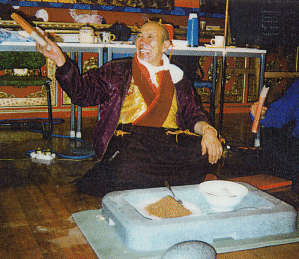| |
TTM points to three
biodynamics , known in Tibetan as nyes pa gsum:
three (potential) pathogens. These group all the various
bodily systems into three groups (related to the elements)
which normaly ensure the overall "good running"
of the psycho-physical complex which is a human being. As
such we could almost call them "Three healthogens".
However, when their normal functioning is disrupted, they
become pathogenic and eventually illness ocurs. These three
biodynamics are very similar to the tridosha of Indian
ayurvedic medicine (see note
below).
Like a good mechanic caring
for a car engine, the TTM physician tries to spot weaknesses
in the system before specific breakdown occur on their account.
Some of TTM is therefore a prophylactic medicine dealing
with unhealthy tendencies before they cause the patient
to present with serious clinical problems. However, since
many people only consult a doctor when things are quite
badly wrong, the major part of this medical science - in
practice - is concerned with an immediate treatment of the
specific ailment with which the patient presents while at
the same time dealing with any underlying imbalance discovered
in the three domains of pathology .
Many notions of physiology,
pathology and therapeutics
found in TTM have their origins
in Indian Buddhist and Siddha medicine. Buddhism was
itself eradicated in India from the 12th century CE. Its
medical science became integrated with Hindu ayurvedic
medicine, predominant in the north of the subcontinent.
A rather diminished form of Siddha
Medicine still exists in the south.
TTM describes anatomy through
an extended metaphor of a house,
in which in which there are major channels
of life-sustaining activity, some very critical
points to protect and certain metabolic pathways
to nurture. In the body, there are certain vulnerable mechanisms
which become the targets
of pathogenic aggression. Life is principally sustained
by the metabolic heat of digestion
and the subsequent sevenfold
metabolic chain, regenerating the bodily tissues and
producing excreta. The metabolic process is very important
in Tibetan medicine, which sees good diet and digestion
as the main key to good health. The three
great domains of pathology play important roles in digestion
and this sevenfold metabolic chain. They are the vectors
of good health, when in balance and undisturbed, and of
illness, when disturbed. In the latter case they are known
as the origins of pathogenic
aggression.
The basis for diagnosis
of ailments depends upon - as in all medical systems - the
perspicacity of the physician. Logic and deduction play
a major role in the doctor's assessment of the situation.
The more so, as here we are in a world without blood tests,
x-rays or laboratories. Using the evidence gathered through
a general physical examination,
careful questioning,
thorough and subtle pulse
palpation and urine examination,
the physician sets in motion a programme of treatment designed
to bring the person back into balanced health. This
can involve any or all of four levels of therapeutic
means:
 advice
on lifestyle, showing
how work, environment, personal and family relationships
etc. influence health, advice
on lifestyle, showing
how work, environment, personal and family relationships
etc. influence health,
 dietary
regulation, using food and drink intelligently to help
the body back to balance, dietary
regulation, using food and drink intelligently to help
the body back to balance,
 medication
involving over 2,000 substances, usually in combination
(sometimes up to 70 or more are present in one medicine).
These are designed to either calm or cleanse
Calming treatments take the form of decoctions, pills, powders,
pastes, medicinal butters, calcinates, extracts and medicinal
brews. Cleansing remedies include lubricatives, purgatives,
emetics, nasal medications, enemata and those which cleanse
the system generally. medication
involving over 2,000 substances, usually in combination
(sometimes up to 70 or more are present in one medicine).
These are designed to either calm or cleanse
Calming treatments take the form of decoctions, pills, powders,
pastes, medicinal butters, calcinates, extracts and medicinal
brews. Cleansing remedies include lubricatives, purgatives,
emetics, nasal medications, enemata and those which cleanse
the system generally.
 various
(mainly external) treatments.
such as medicinal baths, ointments, hot or cold fomentations,
blood-letting, moxibustion and minor surgery. various
(mainly external) treatments.
such as medicinal baths, ointments, hot or cold fomentations,
blood-letting, moxibustion and minor surgery.
The physician follows a
high moral and ethical code. This is seen as playing an
important role in the healing art. The general idea is to
reduce subjectivity, by the physician being - in general
and especially during consultation and pulse
palpation - not simply another human being complicating
the situation with his own personal presence and subjective
interpretation, but a calm presence of universal, compassionate
peace: a sort of universal mirror which will reflect accurately
the situation of the patient. Pulse palpation is perhaps
the most vivid example of this. Pulse is said to be the
messenger between the patient and the docotr. Some Tibetan
physicians describe pule palpation as "listening to
the patient's body". To achieve the state of deep quiet
needed to 'listen' effectively, the physician trains in
meditation and prayer. In the past, most TTM doctors were
Buddhist and their professional practice was their own path
of spirituality and their way of serving the community.
One should neither underestimate nor overestimate this spiritual
dimension of TTM. Results from TTM clinics with doctors
trained under the Communist regime (i.e. without the Buddhist
aspect of training) have shown that TTM stands very effectively
on its own feet as a medical system without it. However,
those TTM doctors with wide experience of TTM both with
and without the spiritual and ethical dimension all seem
agreed that it is more effective with it, especially concerning
the doctor-patient relationship.
|

